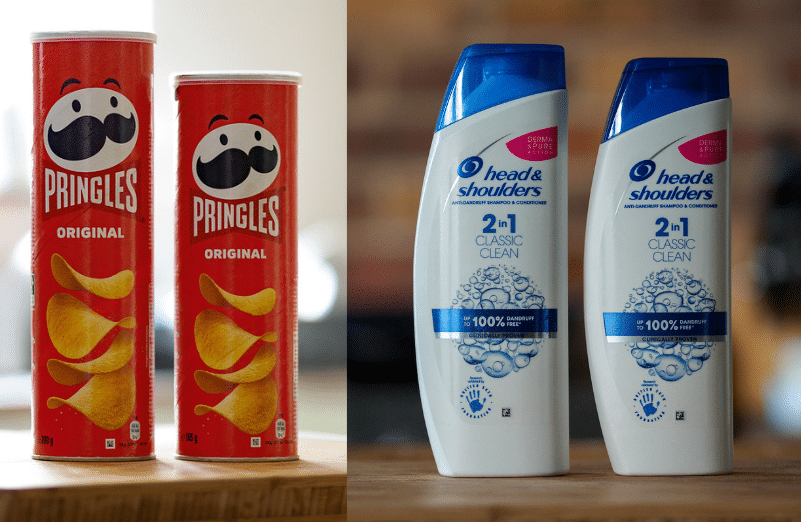
Price hikes are unfortunate. Surreptitiously shrinking product packages is just plain sneaky. So a vast majority of shoppers say companies engaging in “shrinkflation” should be forced to fess up.
Perdue University’s Center for Food Demand Analysis and Sustainability surveyed shoppers for its latest Consumer Food Insights report. The focus of this latest monthly survey was shrinkflation, the practice of reducing package sizes and selling them for the same price as before. Manufacturers see it as a way to avoid raising prices and turning off shoppers. But many shoppers are turned off nonetheless, seeing it as a way to trick them into paying more for less.
77% of the shoppers surveyed said they have noticed shrinkflation in some or many of the food products they’ve seen lately at the grocery store. Snack foods are by far seen as the biggest culprits, with 78% of shoppers noticing smaller packages with fewer snacks inside. About half said they’ve also noticed shrinkflation in packaged desserts and frozen foods.
That’s if they notice at all, though. “Detecting shrinkflation in a product can be more difficult than detecting changes in price unless consumers are aware of the typical weight and unit price of the product,” Purdue noted. And unless the new and old products are side by side on the shelf so you can see the difference, shrinkflation often goes unnoticed. Most shoppers said they always or often check prices, but only about half always or often check the weight or unit price of an item. “Unit price is an important indicator of the value consumers are getting for their food,” Purdue pointed out. The survey results indicate “that most consumers are likely to notice changes in overall prices but potentially miss changes in shrinkflation indicators.”
So what to do about it? Some shoppers want to take matters into their own hands, while others want the government to step in. Two-thirds of survey respondents said they’re less likely to trust brands that practice shrinkflation, and 59% said they would switch to a different brand if they noticed shrinkflation in a product they typically buy.
But most said it shouldn’t be up to them to discern when their favorite products have suddenly become smaller. Three-quarters of shoppers agreed with the statement “companies should be required by law to put clear labels on food packages that let the consumer know the product has been reduced in size or quantity.”
A French grocery chain ran with that idea and took matters into its own hands last year, when it stuck labels on the shelves in front of products that had been reduced in size, to make sure shoppers were aware – and that they knew the manufacturer and not the retailer was responsible.
Here in the U.S., a group of Democratic U.S. Senators proposed something similar earlier this year. Companies “seek to deceive consumers when they practice shrinkflation without clearly disclosing the size change and per unit price increase of a product,” Senator Bob Casey of Pennsylvania said in announcing his “Shrinkflation Prevention Act of 2024.” The bill would direct the Federal Trade Commission to “establish shrinkflation as an unfair or deceptive act or practice,” potentially making it illegal unless the change is clearly disclosed to shoppers. “Corporations are trying to pull the wool over our eyes by shrinking their products without reducing their prices,” Casey said. “Families are sick and tired of digging deeper into their wallets for their weekly grocery runs while corporate CEOs laugh all the way to the bank.”
Most shoppers participating in the Purdue survey were as cynical about the practice as Casey. 82% said they believe shrinkflation is a common practice among food companies, and 76% believe shrinkflation is “used by companies to increase their profits even when costs are not rising.”
When push comes to shove, though, some shoppers say shrinkflation is better than the alternative. When given a specific example of shrinkflation and whether they’d prefer a price hike instead, most shoppers preferred the size decrease instead. Perdue asked shoppers to picture a single-serve snack that costs $3. Would they rather pay $3 for a smaller size product, or would they rather the size stay the same but the price go up to $3.60? A majority said they’d rather pay the same price for a smaller snack.
That’s “contrary to some previous survey findings,” Purdue noted. A recent survey from LendingTree discovered that more shoppers would prefer companies to raise prices rather than reduce sizes. But that survey focused on all products, while Purdue’s survey focused on food products alone. LendingTree found that “household paper products — toilet paper and paper towels — saw the highest rate of change via fewer sheets per roll.” That’s in sync with what Senator Casey found when proposing his legislation. He cited findings from the Bureau of Labor Statistics showing that household paper products are most impacted by shrinkflation.
So it could be that buyers of certain, costlier products don’t mind paying more for less. Buyers of a single-serve snack, in contrast, might prefer that the low price point stay the same.
Regardless of their personal preferences, some shoppers are resigned to the phenomenon. 52% in the Purdue survey said they believe shrinkflation is “an unavoidable response to rising costs and inflation.” And 22% actually said they are “fine with shrinkflation, because it helps me reduce the number of calories I eat or drink.”
That’s certainly one way to look at it. Manufacturers might hope that everyone feels that way. Their sales figures will ultimately determine whether their tactics are working – or whether shoppers just aren’t buying it.










